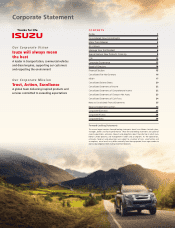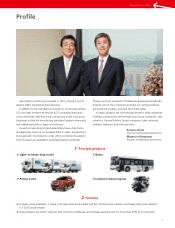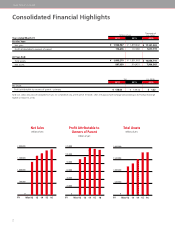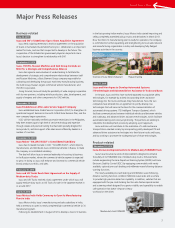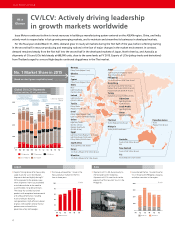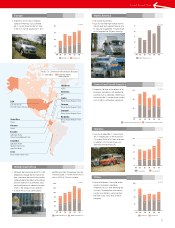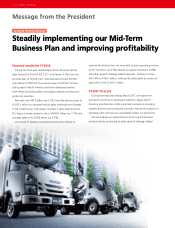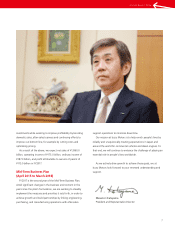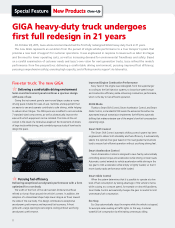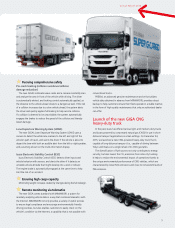Isuzu 2016 Annual Report Download - page 12
Download and view the complete annual report
Please find page 12 of the 2016 Isuzu annual report below. You can navigate through the pages in the report by either clicking on the pages listed below, or by using the keyword search tool below to find specific information within the annual report.
ERGA heavy-duty bus undergoes
first full redesign in 15 years
Putting smiles on users’ faces with ERGA
Barrier-free universal design
Isuzu improved safety around priority seats by orienting them so that
they face forward, and adding new handrails. We also added inverted
ramps to simplify and speed wheelchair access, and new retractable
belts for securing wheelchairs in place to make that process less labor-
intensive.
The fuel tank was moved to the upper portion of the left front wheel
well to facilitate a flat floor in the interior. This design change allows the
priority seats to be oriented so that they face forward and increases the
size of the non-step area. As an additional benefit, the vehicle can hold
more passengers.
Exterior
Lengthening ERGA’s wheelbase without changing its overall length
enabled an increase in the size of the non-step area. In addition, shorter
front and rear overhangs and accompanying increases in approach and
departure angles give the vehicle an ability to negotiate abrupt gradient
changes such as steep ramps that is on par with that of a one-step vehicle.
On August 18, 2015, Isuzu announced
and launched the first fully redesigned
ERGA heavy-duty bus in 15 years.
Inside overall view
Inverted ramp
To increase interior height, the ERGA’s total height is higher than
current non-step models but lower than current one-step models. The
result is a bus with a comfortable interior as well as excellent ability to
negotiate grade changes.
A new 11.1 m class model is also available for use in high-capacity
applications. This model offers a non-step area of unprecedented size.
Engine
The ERGA uses a lightweight, compact 250 hp 4HK1-TCS diesel
engine fitted with a two-stage turbo that improves fuel efficiency by
bringing the benefits of high-efficiency turbocharging to the entire
RPM range.
It also uses a diesel particulate diffuser (DPD) and urea selective
catalytic reduction (SCR) to treat emissions.
The ERGA’s fuel efficiency exceeds the 2015 heavy-vehicle fuel
efficiency standard for vehicles weighing more than 14 tons equipped
with an automated manual transmission by 10%, and the standard
for vehicles weighing more than 14 tons equipped with an automatic
transmission by 5%. The ERGA also qualifies as an Outstanding Low-
emissions Vehicle under the 2009 standard adopted by a certification
program for low-pollution vehicles endorsed by nine Japanese
prefectures and cities.
Refinements to the body structure and adoption of a lower-
displacement engine save about 600 kg in overall vehicle weight, while
further improving fuel efficiency.
Transmissions
The ERGA is available with either an automated manual transmission
(AMT) or an automatic transmission (AT). The AMT preserves manual
shifting but eliminates the need to operate a clutch, allowing the vehicle
to be driven using just the accelerator and brake pedals. It can also
creep forward like an AT. This design enables the bus to be operated by
drivers of any age or gender, even those with little driving experience.
Prognosis functionality was added to the control panel for AT-
equipped vehicles. This function monitors the condition of the oil and
filter, and activates a service indicator to alert the driver at the optimal
time to change the oil.
10


